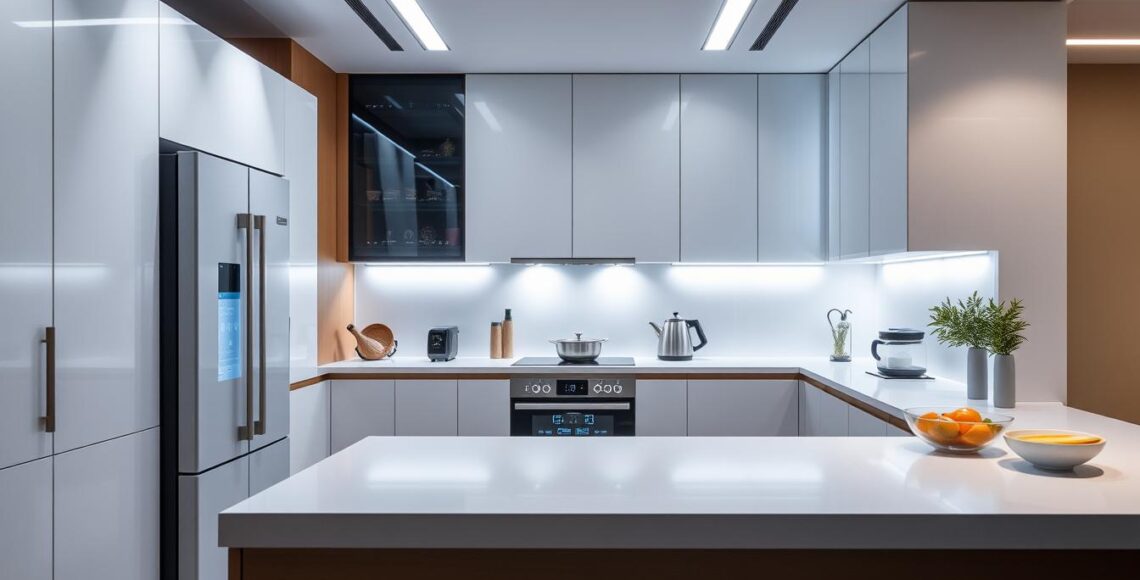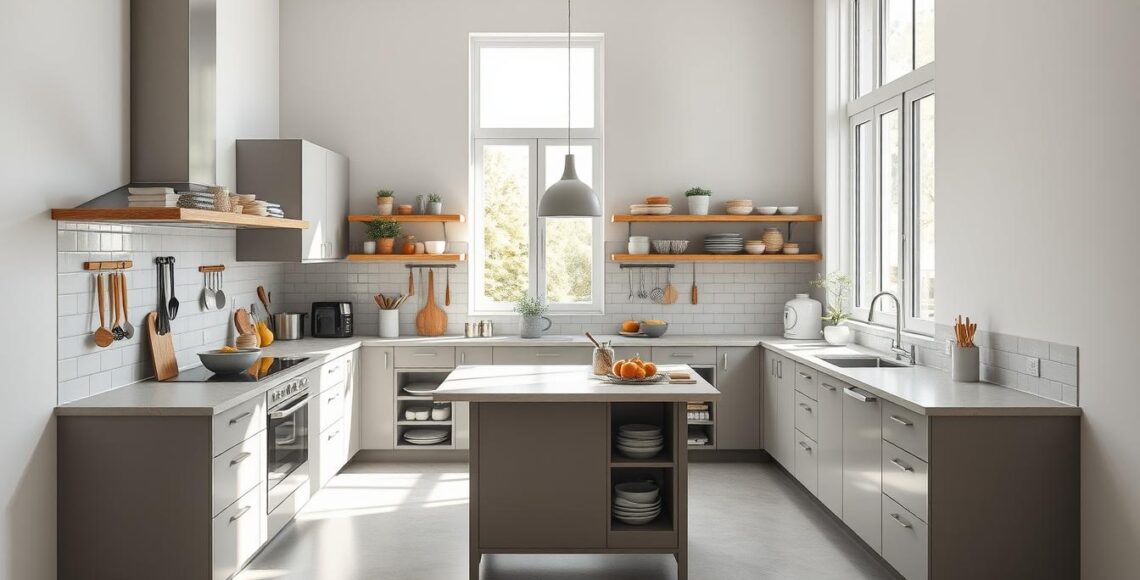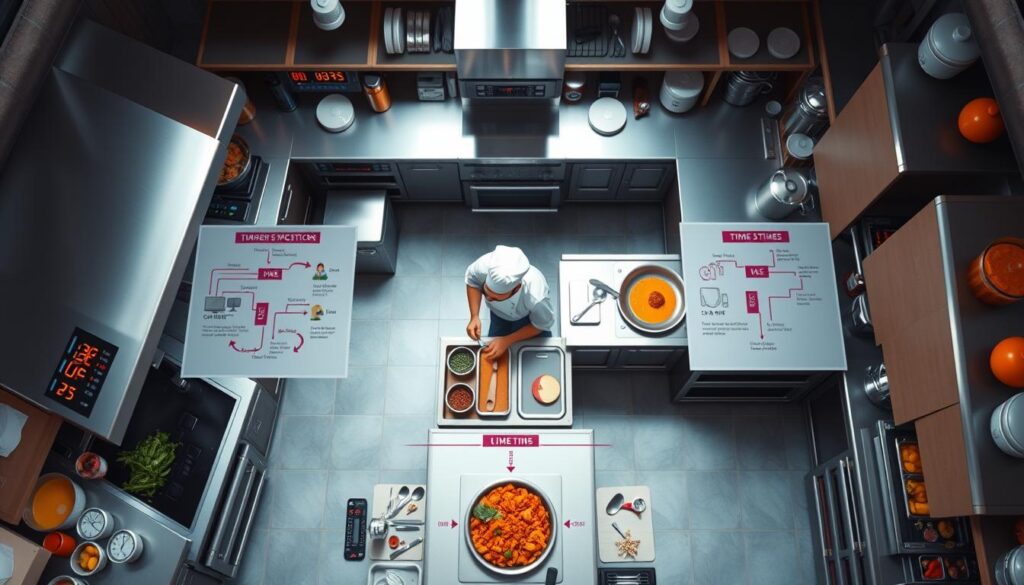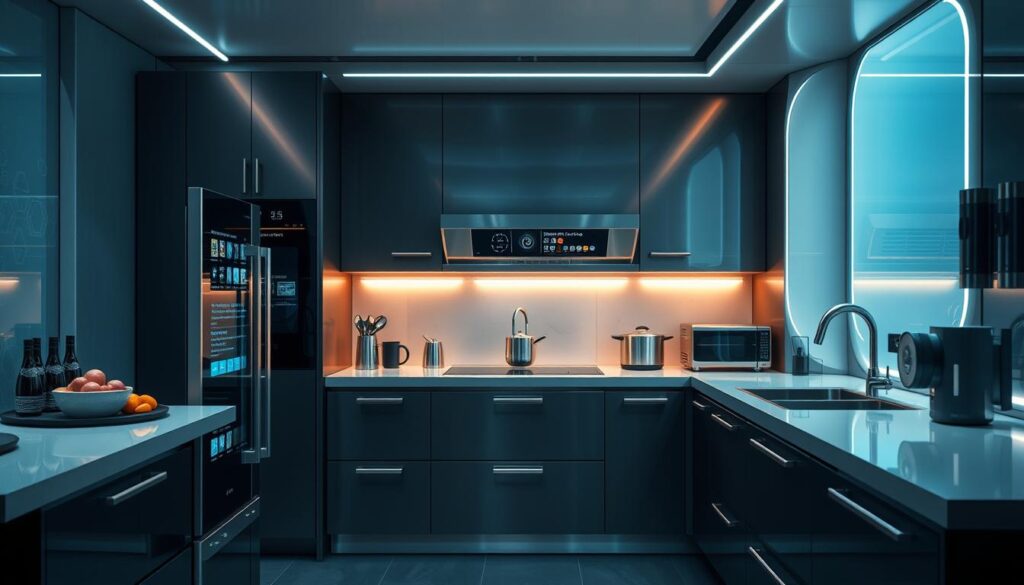Engineering Smart Kitchen Technology Solutions
We recognize the importance of balancing innovation with practicality as we engineer smart kitchen technology solutions. Our goal is to provide a comprehensive guide that bridges the gap between architectural vision and manufacturing reality, focusing on seamless technology integration and system integration.
With expertise in custom cabinetry manufacturing, we will provide actionable insights and practical examples to help architects and contractors navigate the complexities of smart kitchen design, ensuring a successful technology integration and system integration process.
As we delve into the world of smart kitchen technology, we will explore the latest trends, benefits, and challenges associated with integrating these systems into modern kitchens, highlighting the importance of effective technology integration and system integration.
Key Takeaways
- Seamless technology integration is crucial for smart kitchen design
- System integration requires careful planning and expertise
- Custom cabinetry manufacturing plays a key role in smart kitchen technology
- Effective technology integration enhances the overall kitchen experience
- Practical examples and actionable insights are essential for successful system integration
- Partnership and collaboration are vital for bridging architectural vision and manufacturing reality
The Evolution of Smart Kitchen Technology
The smart kitchen technology landscape has undergone significant transformations in recent years, driven by advancements in IoT, AI, and automation. As we navigate this evolving landscape, it’s essential to consider the power requirements and connectivity planning that underpin these innovative solutions.
Some key aspects of smart kitchen technology include:
- Enhanced user experience through voice-controlled interfaces and mobile apps
- Energy efficiency through smart appliances and automated lighting systems
- Increased property value through the integration of high-end smart kitchen solutions
As we delve into the world of smart kitchen technology, it’s crucial to address common integration challenges, such as compatibility issues and data security concerns. By prioritizing connectivity planning and power requirements, we can ensure seamless user experiences and efficient system operation.
A well-designed smart kitchen system can provide numerous benefits, including:
- Improved convenience and efficiency
- Enhanced energy efficiency and cost savings
- Increased property value and appeal
By understanding the evolution of smart kitchen technology and its key components, we can better navigate the complexities of power requirements and connectivity planning, ultimately creating more efficient, convenient, and sustainable kitchen spaces.
Understanding Your Kitchen’s Technology Integration Needs
To successfully integrate smart kitchen technology, it is essential to assess the specific needs of your kitchen. We consider factors such as kitchen size, layout, and user behavior to provide guidance on designing and implementing smart kitchen solutions. A well-designed user interface is crucial for a seamless user experience, as it enables easy control and navigation of the various smart devices and systems in the kitchen.
When evaluating your kitchen’s technology integration needs, consider the importance of maintenance access. Easy access to the underlying systems and devices is vital for troubleshooting, repairs, and upgrades. A well-designed smart kitchen should balance functionality with maintainability, ensuring that the systems and devices are easy to access and repair when needed.
- Kitchen size and layout
- User behavior and preferences
- Device and system compatibility
- Ease of maintenance access
- Intuitive user interface design
By considering these factors and designing a smart kitchen with a focus on user interface and maintenance access, architects and contractors can create high-end custom cabinetry manufacturing solutions that meet the unique needs of their clients.
Essential Components of Smart Kitchen Systems
When designing a smart kitchen, it’s crucial to consider the essential components that make up the system. These components work together to ensure seamless system integration and reliability testing. A well-designed smart kitchen system should include core control units, sensor technologies, smart appliance connectivity, and user interface systems.
These components play a vital role in ensuring the system operates efficiently and effectively. For instance, core control units act as the brain of the system, processing data and sending commands to various devices. Sensor technologies, on the other hand, provide real-time data on temperature, humidity, and other environmental factors, enabling the system to make informed decisions.
Core Control Units
Core control units are responsible for processing data and controlling the various devices in the smart kitchen system. They must be reliable and efficient to ensure the system operates smoothly.
Sensor Technologies
Sensor technologies provide real-time data on environmental factors, enabling the system to make informed decisions. This data is crucial for reliability testing and ensuring the system operates within optimal parameters.
Smart Appliance Connectivity
Smart appliance connectivity enables devices to communicate with each other and the core control unit, ensuring seamless system integration. This connectivity is critical for reliability testing and ensuring the system operates efficiently.
User Interface Systems
User interface systems provide an intuitive and user-friendly interface for users to interact with the smart kitchen system. They must be designed with the user in mind, providing a seamless and efficient experience.
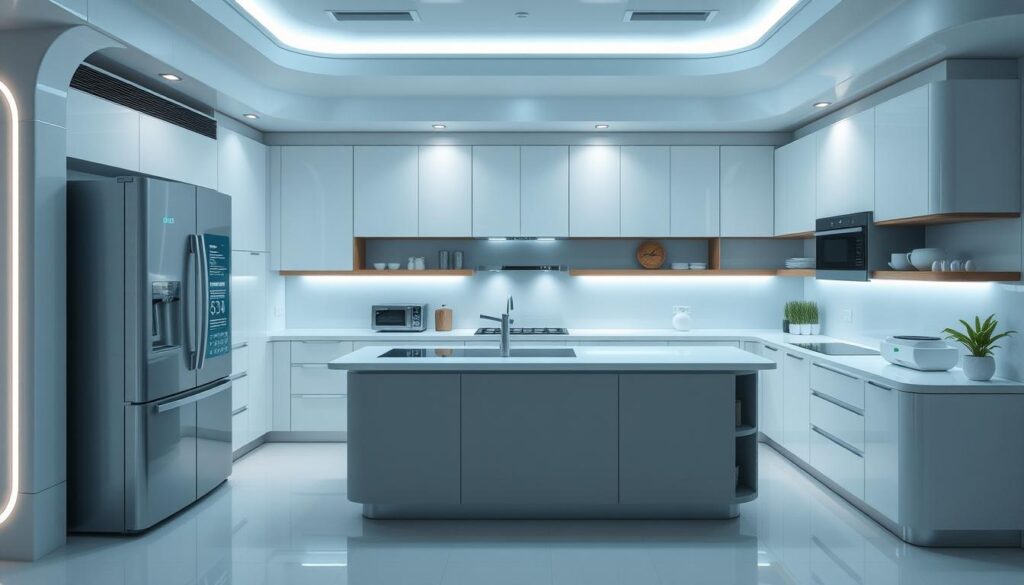
By understanding the essential components of smart kitchen systems and their roles in system integration and reliability testing, architects and contractors can design and implement smart kitchen systems that meet the highest standards of quality and reliability.
| Component | Description |
|---|---|
| Core Control Units | Process data and control devices |
| Sensor Technologies | Provide real-time data on environmental factors |
| Smart Appliance Connectivity | Enable devices to communicate with each other and the core control unit |
| User Interface Systems | Provide an intuitive and user-friendly interface for users |
Power Requirements and Infrastructure Planning
As we design and build smart kitchens, it’s essential to consider the power requirements and infrastructure planning necessary to support these systems. This includes evaluating the electrical infrastructure needs, such as power consumption, wiring, and circuitry, to ensure that our smart kitchens are efficient, sustainable, and ready for future upgrades.
When planning for power requirements, we must consider the upgrade potential of our smart kitchen systems. This means designing infrastructure that is scalable and adaptable to emerging technologies, allowing us to easily integrate new devices and appliances as they become available. By doing so, we can future-proof our smart kitchen investments and ensure that they remain relevant and functional for years to come.
For example, a well-planned infrastructure can support the integration of smart appliances, such as those found at top kitchen appliance manufacturers, which can help reduce energy consumption and enhance the overall cooking experience. By considering power requirements and upgrade potential, we can create smart kitchens that are not only functional and efficient but also sustainable and adaptable to changing technology.
Some key considerations for power requirements and infrastructure planning include:
- Evaluating the electrical infrastructure needs of our smart kitchens
- Designing infrastructure that is scalable and adaptable to emerging technologies
- Integrating smart appliances and devices to reduce energy consumption and enhance functionality
By carefully planning for power requirements and infrastructure, we can create smart kitchens that are efficient, sustainable, and ready for future upgrades, ultimately enhancing the cooking experience and providing a strong foundation for our smart kitchen investments.
Implementing Successful Technology Integration Strategies
As we delve into the world of smart kitchen technology, it’s essential to consider the importance of connectivity planning in ensuring seamless integration and reliable performance. By prioritizing this aspect, architects and contractors can minimize the risk of integration failures and ensure that their smart kitchen solutions meet the highest standards of quality and reliability.
Effective technology integration strategies involve a thorough assessment of device compatibility, network architecture design, and security protocol implementation. This includes evaluating the compatibility of various devices and systems, designing a robust network architecture that can support the demands of smart kitchen technology, and implementing stringent security protocols to protect against potential threats.
To ensure the long-term success of smart kitchen projects, it’s crucial to consider maintenance access and regular updates. This includes scheduling regular software updates, performing routine maintenance tasks, and ensuring that all systems and devices are compatible with future updates and upgrades.
Key Considerations for Successful Integration
- Network architecture design and device compatibility assessment
- Security protocol implementation and regular updates
- Maintenance access and scheduling regular software updates
By following these strategies and considering the importance of connectivity planning and maintenance access, architects and contractors can create smart kitchen solutions that are not only functional and efficient but also secure and reliable.
| Integration Strategy | Benefits |
|---|---|
| Network Architecture Design | Ensures seamless integration and reliable performance |
| Device Compatibility Assessment | Minimizes the risk of integration failures |
| Security Protocol Implementation | Protects against potential threats and ensures data security |
User Interface Design and Accessibility
When designing a smart kitchen system, the user interface plays a crucial role in determining the overall user experience. A well-designed interface should be intuitive, providing clear feedback and easy navigation. This is where system integration comes into play, as it enables seamless interaction between different devices and systems.
To achieve this, we focus on creating a user-centered design that prioritizes accessibility features. This includes incorporating voice control, touch screens, and mobile apps to cater to different user preferences. By doing so, we can ensure that our smart kitchen solutions are both functional and enjoyable to use.
Some key considerations for user interface design include:
- Intuitive controls and clear feedback
- Accessibility features, such as voice control and touch screens
- Seamless integration with other smart devices and systems
By prioritizing user interface design and accessibility, we can create smart kitchen solutions that enhance the overall cooking experience. As we continue to innovate and improve our designs, we must remember that the user interface is the backbone of any smart kitchen system, and its design should always be driven by the needs of the user.
System Reliability and Performance Testing
Ensuring system reliability and performance is crucial to the success of any smart kitchen project. We prioritize reliability testing to identify and address potential issues before they become major problems. This proactive approach helps minimize the risk of integration failures and ensures that our smart kitchen solutions meet the highest standards of quality and reliability.
Regular maintenance access is also essential for preventing system downtime and ensuring continuous operation. By scheduling routine checks and performing necessary updates, we can prevent minor issues from escalating into major problems. This not only saves time and resources but also provides peace of mind for homeowners and users.
Our quality assurance protocols include rigorous testing and evaluation to ensure that all components and systems work seamlessly together. We also establish clear performance metrics to measure the success of our smart kitchen solutions and make data-driven decisions for future improvements.
By prioritizing system reliability and performance testing, we can guarantee that our smart kitchen solutions meet the highest standards of quality and reliability, providing a seamless and enjoyable user experience.
Maintenance and Support Considerations
As we continue to integrate smart kitchen technology into our homes, it’s essential to consider the maintenance and support requirements necessary to ensure continuous operation. Regular software updates and firmware upgrades are crucial in preventing system downtime and ensuring seamless integration. Easy maintenance access is also vital, allowing architects and contractors to quickly and efficiently address any issues that may arise.
When designing smart kitchen systems, we must prioritize upgrade potential to ensure that our solutions remain functional, efficient, and adaptable to emerging technologies. This includes considering the scalability of our systems and the potential for future upgrades. By doing so, we can ensure that our smart kitchen solutions continue to meet the evolving needs of homeowners.
Some key considerations for maintenance and support include:
- Regular software updates to prevent system downtime
- Firmware upgrades to ensure seamless integration
- Easy maintenance access for quick issue resolution
- Upgrade potential to ensure scalability and adaptability
By prioritizing maintenance and support, we can ensure that our smart kitchen solutions continue to provide value to homeowners for years to come.
| Maintenance Consideration | Importance |
|---|---|
| Regular Software Updates | High |
| Firmware Upgrades | High |
| Easy Maintenance Access | Medium |
| Upgrade Potential | High |
Future-Proofing Your Smart Kitchen Investment
As we continue to navigate the evolving landscape of smart kitchen technology, it’s essential to consider the long-term implications of our investments. By prioritizing upgrade potential and system integration, we can ensure that our smart kitchen solutions remain relevant and functional in the years to come.
We believe that designing smart kitchen systems with adaptability in mind is crucial for future-proofing. This involves staying informed about emerging technologies and industry trends, allowing us to capitalize on new opportunities and stay ahead of the curve. Some key considerations for future-proofing include:
- Regular software updates to ensure compatibility with new devices and technologies
- Modular design to facilitate easy upgrades and replacements
- Open communication protocols to enable seamless system integration
By prioritizing upgrade potential and system integration, we can create smart kitchen solutions that are not only cutting-edge but also sustainable and efficient. As we move forward, it’s essential to continue monitoring industry trends and adapting our strategies to stay ahead of the curve.

Conclusion: Maximizing Your Smart Kitchen’s Potential
In conclusion, engineering smart kitchen technology solutions requires a comprehensive understanding of the intricate intersection between innovation, design, and user experience. By following the principles and strategies outlined in this comprehensive guide, architects and contractors can create smart kitchen systems that truly maximize the potential of this transformative technology.
Through thoughtful integration of essential components like control units, sensor technologies, and intuitive user interfaces, smart kitchens can deliver unparalleled convenience, efficiency, and enhanced property value. Careful planning of power requirements and infrastructure ensures a seamless and reliable technology integration, while robust testing and maintenance procedures safeguard system performance over time.
As the smart kitchen landscape continues to evolve, staying attuned to emerging trends and future-proofing your investment will be crucial. By embracing the latest advancements in connectivity, automation, and data-driven optimization, you can future-proof your smart kitchen and unlock new possibilities for culinary innovation, energy savings, and elevated living experiences.
